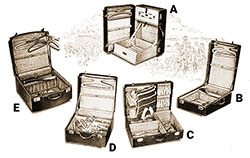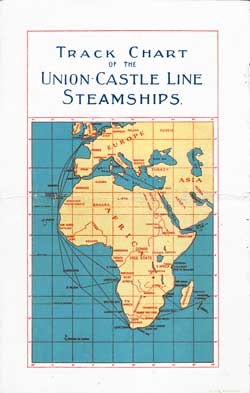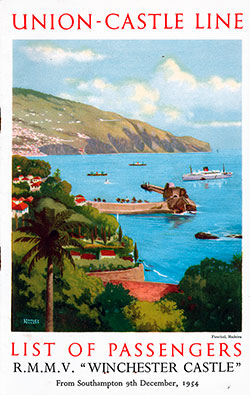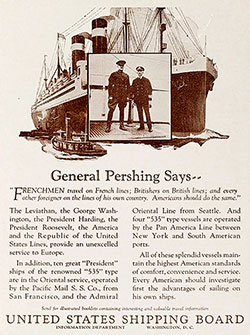Ocean Travel Through the Ages: Stories of Innovation, Adventure, and Social Change
Explore the history of ocean travel through captivating articles on shipboard life, wireless communication, luggage trends, and legendary liners like the Leviathan. Perfect for historians, educators, genealogists, and travel enthusiasts.

The Ocean Voyage on the City of Rome - 1894
"The Ocean Voyage," an article from the Anchor Line published in 1894, provides a vivid portrayal of the transatlantic journey during the late 19th century.

The Ship's Company on the Cunard Line
"The Ship's Company," an article published by the Cunard Line in 1913, provides an in-depth exploration of the roles, responsibilities, and hierarchy within the crew of a passenger steamship during the early 20th century.

The article "Luggage Fashions of 1928," published by The Cunarder, offers an insightful glimpse into the world of travel accessories and the evolving trends in luggage during the late 1920s.

Union-Castle Line Passenger Services - Outward, Homeward and Coastwise
The article "Services - Outward, Homeward, and Coastwise - 1929," published by the United States Lines, provides a comprehensive overview of the various passenger and cargo services offered by the company during the late 1920s.

Union-Castle Line Steamship Fleet List - 1929
Fleet List and Tonnage of the Ships of the Union-Castle Mail Steamship Company, Limited popularily known as the Union-Castle Line.

The article "War of the Wireless" from September 1913 provides an in-depth look at the early 20th-century battle for control over the wireless telegraphy industry, a crucial and revolutionary technology of its time.

The Big Five of the Transatlantic Passenger Trade: Innovation, War, and the Race Across the Atlantic
The transatlantic passenger trade of the early 20th century represents a unique intersection of maritime innovation, geopolitics, and social evolution. The article, "The Big Five of the Transatlantic Passenger Trade," offers a compelling narrative on five key vessels—the Leviathan, George Washington, America, Agamemnon, and Mount Vernon. It explores how these seized German liners were transformed into American maritime assets following World War I.
🌊 Exploring Ocean Travel Through the Ages: A Journey Across Time and Technology
🚢 Introduction: Why This Index Matters
The history of ocean travel offers a rich, multifaceted view of technological innovation, cultural shifts, and human stories. This index of ocean travel articles brings together diverse narratives from 1894 to the mid-20th century, showcasing travel experiences, maritime advancements, and societal trends.
These pieces are invaluable resources for:
🧑🏫 Teachers/Students: Providing historical context for transportation and global connectivity.
🧬 Genealogists: Offering insight into passenger lists, ship details, and migration patterns.
🕰️ Historians: Presenting firsthand accounts of technological milestones and social dynamics.
🌐 Travel Enthusiasts: Revealing the romance and challenges of ocean voyages.
Each featured article captures a different aspect of maritime history, from passenger services to wireless communication to fashionable luggage trends.
🌟 Highlights of the Collection
1. 🚢 The Ocean Voyage on the City of Rome – 1894
Published by Anchor Line, this 1894 article provides a firsthand description of transatlantic travel aboard the SS City of Rome.
The late 19th century marked a transition from sailing ships to steamships, making ocean travel faster and more comfortable.
Passengers experienced:
- Elegant dining rooms with multi-course meals.
- Expansive decks for socializing and scenic views.
- Innovative ship designs that prioritized passenger safety and comfort.
💡 Why It’s Interesting:
- Captures the essence of Victorian-era travel—when crossing the Atlantic was both an adventure and a status symbol.
- Provides valuable insights into the daily routines of passengers and crew operations.
2. ⚓️ The Ship's Company on the Cunard Line – 1913
Published by Cunard Line, this 1913 article delves into the hierarchical structure and responsibilities of a steamship crew.
Ocean liners were self-contained cities, and the crew’s roles ranged from navigation officers to hospitality staff.
Highlights include:
- Captain's authority over navigation and safety.
- Purser's oversight of passenger welfare and financial transactions.
- Stewards' contributions to passenger comfort.
💡 Why It’s Interesting:
- Reveals the human side of ocean travel, illustrating the complex social dynamics on board.
- Educational for students exploring labor structures and maritime traditions.
3. 🧳 Luggage Fashions of 1928
Published by The Cunarder, this 1928 article examines travel accessories and luggage trends.
The Roaring Twenties saw a boom in international travel, driven by economic prosperity and advances in ship design.
Key highlights:
- Hard-sided trunks for ocean crossings.
- Custom-designed luggage for wealthy travelers.
- Compact, durable options for middle-class tourists.
💡 Why It’s Interesting:
- Connects social history with travel habits, illustrating how fashion intersected with functionality.
- Ideal for genealogists interested in passenger lifestyles during the interwar years.
4. 🌐 Union-Castle Line Passenger Services – 1929
Published in 1929, this article details the extensive routes and services of the Union-Castle Mail Steamship Company.
British maritime dominance is showcased through its network linking Britain, Africa, and beyond.
Key aspects:
- Homeward, outward, and coastwise routes.
- Cargo and passenger operations.
- Scheduled sailings that facilitated global commerce and migration.
💡 Why It’s Interesting:
- Maps and schedules provide practical context for understanding migration patterns.
- Great for students studying globalization, as it illustrates the infrastructure behind early global networks.
5. 📡 War of the Wireless – 1913
This 1913 article chronicles the early competition for dominance in wireless telegraphy.
The Marconi Company is highlighted in its efforts to monopolize maritime communications.
Wireless technology was critical for safety and operational efficiency, especially after the Titanic disaster in 1912.
💡 Why It’s Interesting:
- Illustrates the intersection of technology, commerce, and regulation.
- Perfect for STEM education, showing how technological innovation impacts societal norms.
6. 🚢 The Big Five of the Transatlantic Passenger Trade
This article explores five key vessels—Leviathan, George Washington, America, Agamemnon, and Mount Vernon.
Highlights the post-war repurposing of seized German liners into American passenger ships.
Key themes:
- Engineering innovation in ship design.
- Geopolitical context of post-WWI reparations.
- The challenge of maintaining large fleets in a competitive market.
💡 Why It’s Interesting:
- Blends maritime technology with historical context.
- Reveals the economic and logistical challenges of post-war recovery.
🧭 The Most Interesting Insights
🏆 The "War of the Wireless"
The battle for wireless communication mirrors modern tech rivalries (e.g., Apple vs. Android).
Wireless telegraphy was revolutionary, ensuring safety, efficiency, and global communication.
1913 was pivotal—regulation, competition, and innovation collided, shaping the future of maritime communication.
🧳 Luggage as a Symbol of Social Mobility
The 1920s luggage industry reflects the growing accessibility of international travel.
Practical yet stylish trunks catered to emerging middle classes, while luxury pieces became status symbols.
🚢 The Leviathan's Dual Legacy
As a wartime transport turned peacetime luxury liner, the Leviathan embodies the transition from military necessity to leisure travel.
Its size and operational costs highlight the economic realities of grand maritime projects.
🎯 Relevance for Modern Audiences
🧑🏫 For Educators:
Incorporate articles into lessons on industrial innovation, immigration, and global networks.
Create STEM discussions around wireless technology and naval architecture.
🧬 For Genealogists:
Passenger lists and service routes provide clues about family migration patterns.
🕰️ For Historians:
Explore maritime history through the lens of technological advancement and socioeconomic change.
🌐 For Travel Enthusiasts:
Discover the romance of early sea travel, from lavish lounges to practical shipboard routines.
🌊 Conclusion: A Voyage Through Time
This index of ocean travel articles serves as a window into the past, illustrating how maritime innovation shaped global travel and trade. From the social dynamics aboard steamships to the technological revolution of wireless communication, these articles provide insights that transcend time and resonate with today's interconnected world.
The ocean has always connected people—across continents, cultures, and generations. This collection preserves the narratives of those who traveled, worked, and innovated upon the sea, ensuring their stories continue to inspire future explorers. 🌐⚓️
